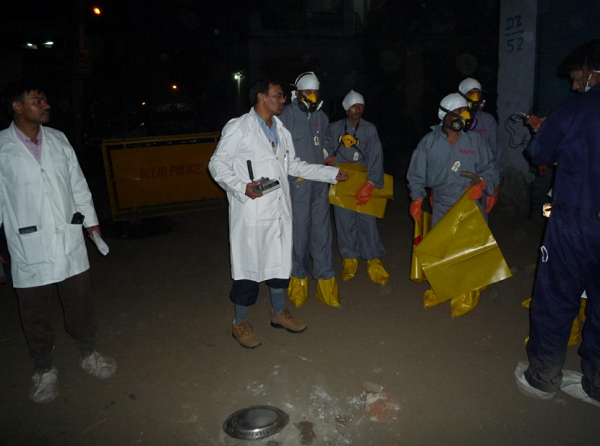Most radioactive sealed sources are sealed in metal capsules that are, in turn, placed into metal containers and shields. From time to time these devices are unknowingly picked up by scrap metal scavengers and are recycled, ending up at scrap metal yards. When sources enter the public domain like this they pose a risk to the public, and many have been injured by such sources. Not only that, but some radioactive sources have been accidentally melted down, contaminating the smelters as well as the consumer products that are made by the contaminated metal.
What happened:
Many research institutions make use of high-activity radioactive sources (housed in irradiators) for some of their research. When the irradiators are no longer needed they’re to be properly disposed of, either by transferring them to another radioactive materials licensee or by paying for disposal as radioactive waste. The University of Delhi, on the other hand, had an irradiator that had been sitting around for 25 years and that would be expensive to dispose of. They assumed that the cobalt-60 had decayed to manageable levels and simply sold the irradiator to a scrap metal dealer, who dismantled the machine. The cobalt “pencils” were removed – one was cut into pieces and distributed to a few workers – causing multiple injuries.
Nuclide(s) and activity:
Cobalt-60, original activity ~4000 curies, activity at time of accident ~20 curies
Response efforts:
The radioactive material consisted of a total of 16 cobalt pencils, each of which contained seven radioactive sources inside. The Indian Atomic Energy Regulatory Board conducted a thorough search of scrap metal yards throughout the New Delhi area and reported recovering all 112 pieces.
In addition to recovering the sources, eight people were exposed to high levels of radiation. They were treated for radiation sickness and various radiation injuries.
Health effects:
One worker, who received an estimated dose of 310 rem, died of radiation sickness and multiple organ failure. Two additional workers were seriously ill but recovered.
Other impacts:
As a result of this accident India changed many regulations related to radioactive sources and the way they are inspected and accounted for. In addition, India has made a greater effort to scan scrap metal for radioactivity to try to prevent a recurrence of this accident.
Interestingly, two years after this incident a number of American consumer products that were made from Indian stainless steel were found to be contaminated with low levels of cobalt-60. These haven’t been conclusively linked to the Mayapuri incident, and the Indian government reported recovering all of the lost radioactive materials. But it seems reasonable to wonder if at least one piece was lost and melted down.
Dr. Zoomie was involved in two of these. In one, I was asked to visit a retail store that stocked a number of items made with stainless steel from India. We surveyed the entire store and found a tissue box holder that gave elevated radiation levels – as high as 14 mR/hr (compared to normal background readings of about 0.005 mR/hr). This piece was taken from the store and turned over to state regulators for disposal. I should note, too, that Mrs. Zoomie had given me many suggestions of things at that particular store that she was hoping might be contaminated and confiscated…she was disappointed to learn that fabric, wood, and ceramic items were unable to be contaminated by a source dropped into scrap metal.
In the other, a colleague who worked for a local sanitation department was contacted about a radiation alarm when a garbage truck passed through radiation portal monitors – the Sanitation Department’s Radiation Safety Officer called Dr. Zoomie and asked if he wanted the offending item (as if he had to ask!). The offending item turned out to be a stainless steel soap dispenser that was contaminated with Co-60, exactly the nuclide from this incident. Given the timing, the medium (stainless steel), and the nuclide involved it seems likely that this was contaminated as a result of the Indian incident. And Dr. Zoomie maintains that this is the nicest gift he has ever received that was pulled out of a dumpster. Sadly, due to the relatively short (5.27 years) half-life of Co-60, this will only be useful for training for another 15-20 years (depending on the detectors used). Luckily, Dr. Zoomie is of an age that this should take him to retirement.
